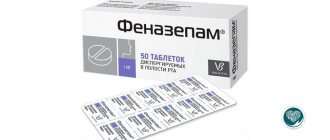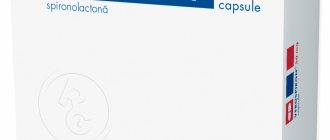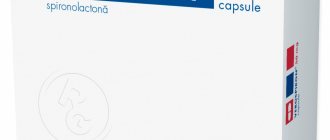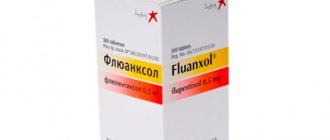"Haloperidol" in the practice of a narcologist
The use of Haloperidol is possible not only for mental disorders. It is used by practicing narcologists to correct behavior in people trying to recover from drug addiction and alcoholism. Indications for prescribing the drug are the following conditions:
- endogenous and pharmacogenic psychosis
- pronounced agitation that does not respond to tranquilizers
- severe depression of mood, apathy
- psychosis due to withdrawal symptoms
- inappropriate behavior when abusing illegal substances
In alcoholics, Haloperidol helps relieve symptoms of delirium. It relieves hallucinosis, paranoia, delirium and other severe mental disorders well. The drug allows you to eliminate acute manifestations of psychosis in drug addicts.
The most frequently asked questions about haloperidol
What happens if a healthy person takes haloperidol?
NOTHING! If a person is truly healthy, then he should not feel any changes. Haloperidol (like any other antipsychotic) has no effect on healthy people.
How long can you be treated with haloperidol?
The duration of haloperidol administration is determined by the attending physician. It can be just one dose (for vomiting, acute psychosis, overexcitation). For chronic diseases, taking haloperidol can last for years (for some types of schizophrenia - for life).
Can I prescribe haloperidol to myself?
It is forbidden. Only a doctor should prescribe any medicine. Haloperidol is sold in pharmacies only by prescription.
Does haloperidol often cause side effects?
Yes. In order to avoid side effects, the doctor must accurately determine the indications and contraindications, correctly calculate the dose and method of administration that is effective and safe from the point of view of side effects. To avoid the side effects of haloperidol associated with changes in muscle tone, so-called “correctors” are used: trihexyphenidyl, biperiden, amantadine and others.
Is haloperidol harmful?
When prescribed by a doctor, haloperidol is not harmful. When self-medicated, taking haloperidol can have a toxic effect on the body.
Is haloperidol helpful?
Yes. The benefits of haloperidol include relieving painful symptoms of psychosis, hallucinations, hyperkinesis (movement disorders), and stopping vomiting.
Drug addiction
When used correctly in normal doses, this medicine is not addictive. But in rare cases of an independent increase in the amount of the incoming substance, withdrawal syndrome appears after refusing it. With abrupt withdrawal of the drug, or long-term use of Haloperidol, mental, neurological and other disorders may occur.
They usually develop in the first days after discontinuation or reduction of dosage, and disappear after 3-4 days. And some changes persist for a month. This reaction is explained by the specific effect of the antipsychotic on neural connections. Its use leads to the relief of excitement, and when “Haloperidol” stops entering the body, dopamine receptors are activated. There is an effect of a sharp release of the substance after previous inhibition. After which you have to resort to symptomatic therapy and carry out rehabilitation.
Signs of withdrawal
Withdrawal syndrome most often develops in people taking typical antipsychotics, which include Haloperidol. This manifests itself in the leveling of all previous effects of the drug. A person develops:
- stress, anxiety
- aggressiveness and irritability
- worsening mental pathology
- severe psychosis (called “hypersensitivity psychosis”)
- tremors, muscle spasms, convulsions, trembling of the whole body
- insomnia
In some cases, dependence on Haloperidol manifests itself in atypical disorders. They are determined by the individual characteristics of the body. A person complains of headache, nausea, indigestion, severe fatigue, and sweating.
Giving help
To prevent withdrawal syndrome after taking Haloperidol, experts recommend not stopping treatment at once. In order to restore the sensitivity of dopamine and other receptors, some time and a gradual reduction in dosage are required. If, for some reason, the antipsychotic has to be discontinued immediately, then in this case it should be replaced with another drug of similar action. An antidepressant, tranquilizer, or nootropic may be suitable as an auxiliary drug.
Symptomatic treatment consists of the use of beta blockers, which help restore the functioning of the heart and blood vessels. To get rid of extrapyramidal disorders, it is recommended to use anticholinergics. And neurological abnormalities and mental manifestations are treated with tranquilizers.
If complex therapy is not effective, the doctor may decide to start taking Haloperidol again until the patient’s condition stabilizes. And after some time, try again to stop the drug by very slowly reducing the dosage. At the same time, constant monitoring of the patient and corrective therapy are necessary.
Effect of haloperidol
The main effect of haloperidol is antipsychotic (can relieve symptoms of psychosis) and antiemetic.
It also has a therapeutic effect for some hyperkinesis (motor disorders). Used by adults and pediatric patients (from 3 years). The therapeutic effect of haloperidol is explained by its effect on dopamine and adrenaline receptors in the central regions of the brain.
Haloperidol has been around for decades and is considered a typical antipsychotic. Its main differences from most other antipsychotics are its pronounced effect in severe psychoses, especially those occurring with hallucinations, and common side effects (changes in muscle tone, drowsiness at the beginning of use, dry mouth, etc.). It is these features that distinguish haloperidol from other antipsychotics.
Indications and contraindications for use are determined by the doctor after examining the patient and clarifying the condition.
Experts' opinion
Most doctors believe that the drug has shown good results over many years of use. It successfully relieves a person from the manifestations of the disease with major and borderline mental disorders. And all the side effects of the drug have been well studied and can be predicted.
To obtain a therapeutic effect and avoid complications, you should never take an antipsychotic without control. Only a specialist can fully calculate the harm and benefit that the drug brings and select the dosage. If you do not take into account contraindications and do not follow the instructions of the treating doctor, overestimating the recommended dose, you cannot exclude a high risk of complications. They will certainly manifest themselves with negative symptoms with multiple disorders of the mental state and functioning of internal organs.
Release form and composition
Haloperidol is a typical antipsychotic. The active substance in the medicine is a butyrophenone derivative of the same name. The medicine is produced in various forms, which allows you to accurately select the required dosage.
The most popular products are for oral use: tablets and concentrate. A second form of the medication is also available as a nasal spray. Tablets can be purchased in different dosages - 1.5 mg or 5.0 mg.
Haloperidol is produced in the form of a short-acting solution, which is intended for intramuscular and intravenous administration. In addition, a long-acting medicine is offered, which is administered intramuscularly and maintains its effect for 3 weeks.
Indications for use of the drug Haloperidol tablets
- acute and chronic psychoses of various etiologies, accompanied by agitation, hallucinatory and delusional disorders, manic states, psychosomatic disorders;
- behavioral disorders, personality changes (paranoid, schizoid, etc.), Gilles de la Tourette syndrome in children and adults;
- tics, Huntington's chorea;
- vomiting and hiccups, long-lasting and resistant to other therapy, including those caused by antitumor therapy;
- in the preoperative period to prevent vomiting.
Overdose
Manifested by tremors, muscle rigidity , and a drop in blood pressure. In severe cases, shock, respiratory depression, and coma are recorded. Gastric lavage and administration of enterosorbents are required. Norepinephrine and albumin are used to improve blood circulation. epinephrine is unacceptable . Antiparkinsonian drugs and central anticholinergic blockers can reduce the severity of extrapyramidal symptoms. Dialysis has not proven effective.
Contraindications
The medicine is not used for severe depression of the central nervous system, for intolerance to the active substance, for central nervous system pathology, which is accompanied by extrapyramidal and pyramidal symptoms, for breastfeeding , hysteria, depression, Parkinson's disease, during pregnancy, for children under three years of age. In case of impaired intracardiac conduction, with angina pectoris, prolongation of the QT interval, with angle-closure glaucoma, with hypokalemia, decompensated heart disease, with epilepsy, thyrotoxicosis, kidney and liver pathology, with respiratory and pulmonary heart failure, with alcoholism, prostatic hyperplasia with urinary retention , in acute infectious diseases, in COPD, Haloperidol is used with caution.
Buy Haloperidol decanoate injection solution 50mg/ml 1ml No. 5 in pharmacies
Haloperidol decanoate Buy Haloperidol decanoate in pharmacies DOSAGE FORMS solution for intramuscular injection, oily 50mg/ml solution for injection, oily 50mg/ml
MANUFACTURERS Gedeon Richter A.O. (Hungary) Gedeon Richter JSC (Hungary)
GROUP Neuroleptics - butyrophenone derivatives
COMPOSITION Active substance - Haloperidol
INTERNATIONAL NON-PROPENTED NAME Haloperidol
SYNONYMS Haloper, Haloperidol, Haloperidol-Acri, Haloperidol-Ratiopharm, Haloperidol-Richter, Haloperidol-Ferein, Senorm
PHARMACOLOGICAL ACTION Anticonvulsant, analgesic, antihistamine, antiemetic, neuroleptic, antipsychotic, sedative. Although the complex mechanism of the therapeutic action of haloperidol is not precisely established, it is known that it has a selective effect on the central nervous system through competitive blockade of postsynaptic dopamine D2 receptors in the limbic dopaminergic structures of the cerebral cortex and causes an increase in the circulation of dopamine in the brain, resulting in an anxiolytic effect. When using the drug to treat subacute conditions, blockade of depolarization or a decrease in the degree of excitation of dopamine neurons and blockade of postsynaptic D2 receptors lead to the manifestation of antipsychotic activity. Eliminates persistent personality changes, delusions, hallucinations, mania. Affects vegetative functions. When taken orally, it is absorbed quite completely. In the blood it is almost completely bound to plasma proteins. Metabolized in the liver. Penetrates histohematic barriers, including the BBB. It is excreted in urine, bile and feces, and passes into breast milk. The extended-release form of haloperidol decanoate acts as a prodrug, slowly and gradually releasing haloperidol from the solvent.
INDICATIONS FOR USE Psychomotor agitation of various origins (mania, dementia, mental retardation, psychopathy, acute and chronic schizophrenia, chronic alcoholism), delusions and hallucinations, paranoid states, acute psychosis, chorea, incessant vomiting, psychomatic agitation, behavioral disorders in old age and childhood. , stuttering, hiccups.
CONTRAINDICATIONS Hypersensitivity, including to sesame oil, central nervous system diseases accompanied by pyramidal and extrapyramidal symptoms, depression, coma, pregnancy, lactation, age under 3 years.
SIDE EFFECTS : Headache, insomnia or drowsiness, agitation, restlessness, anxiety, fears, euphoria or depression, lethargy, epileptic seizures, hallucinations. With longer use, extrapyramidal disorders, tardive dyskinesia, neuroleptic malignant syndrome, accompanied by hyperthermia, muscle rigidity, loss of consciousness. When used in high doses - hyposalivation, nausea, vomiting, constipation or diarrhea, arterial hypotension, tachycardia, arrhythmia, ECG changes, sometimes liver dysfunction, acne-like skin changes, rarely - visual disturbances, laryngospasm, bronchospasm, pain in the mammary glands, gynecomastia, menstrual irregularities, impotence, increased libido, urinary retention, sweating, alopecia, temporary leukopenia, erythropenia, hyperprolactinemia, hyper- and hypoglycemia, hyponatremia, photosensitivity.
INTERACTION Enhances the effect of antihypertensive drugs, opioid analgesics, antidepressants, barbiturates, alcohol, weakens indirect anticoagulants. Inhibits the metabolism of tricyclic antidepressants and increases toxicity. With long-term use of carbamazepine, plasma levels of haloperidol fall. In combination with lithium, it can cause an encephalopathy-like syndrome.
METHOD OF APPLICATION AND DOSAGE Intramuscularly, the dosage regimen is individual, usually 50-200 mg once every 4 weeks.
OVERDOSE Symptoms: severe extrapyramidal disorders, arterial hypotension, drowsiness, lethargy. In severe cases, coma, respiratory depression, shock. Treatment: there is no specific antidote. Gastric lavage and subsequent administration of activated charcoal are possible. In case of respiratory depression - mechanical ventilation, with a pronounced decrease in blood pressure - administration of plasma-substituting fluids, plasma, norepinephrine, to reduce the severity of extrapyramidal disorders - central anticholinergic blockers and antiparkinsonian drugs.
SPECIAL INSTRUCTIONS Prescribe with caution to patients suffering from cardiovascular diseases with symptoms of decompensation, conduction disorders of the heart muscle and kidney function. With the development of tardive dyskinesia, a gradual dose reduction is recommended, until discontinuation. During therapy, patients must refrain from engaging in potentially hazardous activities that require increased attention and rapid mental and motor reactions.
STORAGE CONDITIONS List B. Store in a dry place, protected from light, at room temperature, out of the reach of children.
Instructions for use of Haloperidol (Method and dosage)
Haloperidol tablets, instructions for use
Take orally with a full glass of milk and water. The initial dosage is 0.5-5 mg three times a day. No more than 100 mg per day. The duration of therapy is 2-3 months. The drug is discontinued gradually, the dosage is reduced slowly, and maintenance doses are switched to - 5-10 mg per day.
Tourette's disease, non-psychotic behavioral disorders: 2-3 times a day 0.05 mg/kg/day, with a gradual increase in dose by 0.5 mg once a week to a maximum of 0.075 mg/kg/day.
Using the solution
The average single dosage for intramuscular administration of Haloperidol is 2-5 mg, the interval between injections is 48 hours. Acute alcoholic psychosis: intravenously 5-10 mg.
Instructions for Haloperidol Ratiopharm drops
Typically consumed up to three times a day with food.
Adults are usually prescribed 0.5-1.5 mg 3 times a day. Further, the dose of the drug can be increased to an average of 10-15 mg per day. For acute symptoms, it is allowed to take 15 mg per day or more. The maximum dose is 100 mg per day.
The initial dose for children from three years of age is 0.025-0.05 mg per kg of body weight, taken 3 times. The maximum can be increased to 0.2 mg per kg of body weight.
Drug interactions Haloperidol tablets
Haloperidol potentiates the inhibitory effect on the central nervous system of centrally acting antihypertensive drugs, opioid analgesics, hypnotics, antidepressants, anesthetics, and alcohol. When used simultaneously with antiparkinsonian drugs (levodopa, etc.), their therapeutic effect may decrease due to the antagonistic effect on dopaminergic structures. Haloperidol may reduce the effectiveness of epinephrine and other sympathomimetics and cause a paradoxical decrease in blood pressure when used. When combined with antiepileptic drugs, the dose of the latter should be increased, since haloperidol reduces the threshold for convulsive readiness. Haloperidol affects the activity of indirect anticoagulants, so when they are taken in combination, the dose of the latter should be adjusted. Haloperidol slows down the metabolism of tricyclic antidepressants, resulting in an increase in their plasma levels and toxicity. When haloperidol is taken concomitantly with fluoxetine and lithium, the risk of side effects on the central nervous system, especially extrapyramidal reactions, increases. When administered concomitantly with antihistamines, the anticholinergic effects may be enhanced. Potentiates the effect of sleeping pills, narcotics, analgesics and other drugs that depress the function of the central nervous system. When taking the drug simultaneously with tea or coffee, the effect of haloperidol may be reduced.
Haloperidol price, where to buy
The price of Haloperidol tablets 1.5 mg 50 pieces is 45-50 rubles.
10 ampoules of 5 mg/ml cost approximately 75 rubles.
- Online pharmacies in RussiaRussia
ZdravCity
- Haloperidol-Richter solution for intravenous and intramuscular injection.
5 mg/ml 1 ml 5 pcs. JSC Gedeon Richter 120 rub. order - Haloperidol Welfarm solution for intravenous and intramuscular injection. 5mg/ml 1ml 10pcs Velpharm LLC
102 RUR order
- Haloperidol solution for intravenous and intramuscular injection. 5mg/ml 1ml 10pcsOzon LLC
94 RUR order
- Haloperidol tablets 1.5 mg 50 pcs. Ozon LLC
47 RUR order
- Haloperidol-Ratiopharm drops for internal use. approx. 2mg/ml 30ml Merckle GmbH.
52 RUR order
special instructions
Regular monitoring of liver test levels, ECG dynamics, and blood parameters are required. Parenteral administration of the drug is carried out only under the supervision of the attending physician. After achieving a therapeutic effect, they switch to taking tablet forms of the drug. If tardive dyskinesia during treatment, a gradual reduction in dosage is required until complete cessation. When taking a hot bath, heat stroke due to the suppression of peripheral, central thermoregulation located in the hypothalamus. Caution is required when performing strenuous physical work. It is not recommended to use over-the-counter “anti-cold” medications during the entire treatment period due to the risk of heat stroke and increased anticholinergic effects. Due to the risk of photosensitivity, patients must protect exposed skin from exposure to sunlight. Haloperidol is discontinued gradually due to the risk of developing withdrawal syndrome. Often, the antiemetic effect of the drug masks signs of drug toxicity , and also complicates the diagnosis of conditions that are accompanied by nausea. Haloperidol may precipitate when mixing its solution with tea or coffee. Before prescribing long-acting forms of the drug, the patient is transferred to Haloperidol from other antipsychotics to prevent sudden hypersensitivity to the drug. The medication affects driving.
The medicine is described in Wikipedia.
INN: haloperidol.
OKPD: 24.42.13.693






